|
|
Post by squawberryman on Jun 1, 2017 11:19:19 GMT -5
Tooooooools........
|
|
|
|
Post by Lee Martin on Jun 6, 2017 19:14:26 GMT -5
Match #11 – VFS, Mechanicsville, VA ____________________________________________ 100 yard varmint for score – It was a nice day to shoot. Winds were manageable with temps in the mid-80s. The match couldn’t have run smoother. I finished with a 249-13X, which was middle of the pack. The dropped point was on me, but I shot a tricky bench. At BCGC, there’s a trap bunker at 40 yards. Bench #14 and #15 have to shoot over it. Just the luck of the draw, I got #14. That concrete base blocked the bottom of the far streamers and I missed a heavy switch. Just as I touched the trigger on what I thought was a flicker, the ribbon went nine o’clock. The bullet missed the 10-ring by only thousandths, high and to the left. A .30-caliber would’ve caught the edge, netting a clean 250 for the day. There were also 5 narrowly missed X’s which would’ve scored on a .308” hole. But enough excuses. It could’ve-should’ve-would’ve been a 250-18X with a thirty. Time to stop talking about the .30 Stingray and get it barreled. View of the trap bunker. My two flags past the pad are visible when standing. When seated, all I could see were the vanes and the top quarter of the streamers when pointed 6:00. 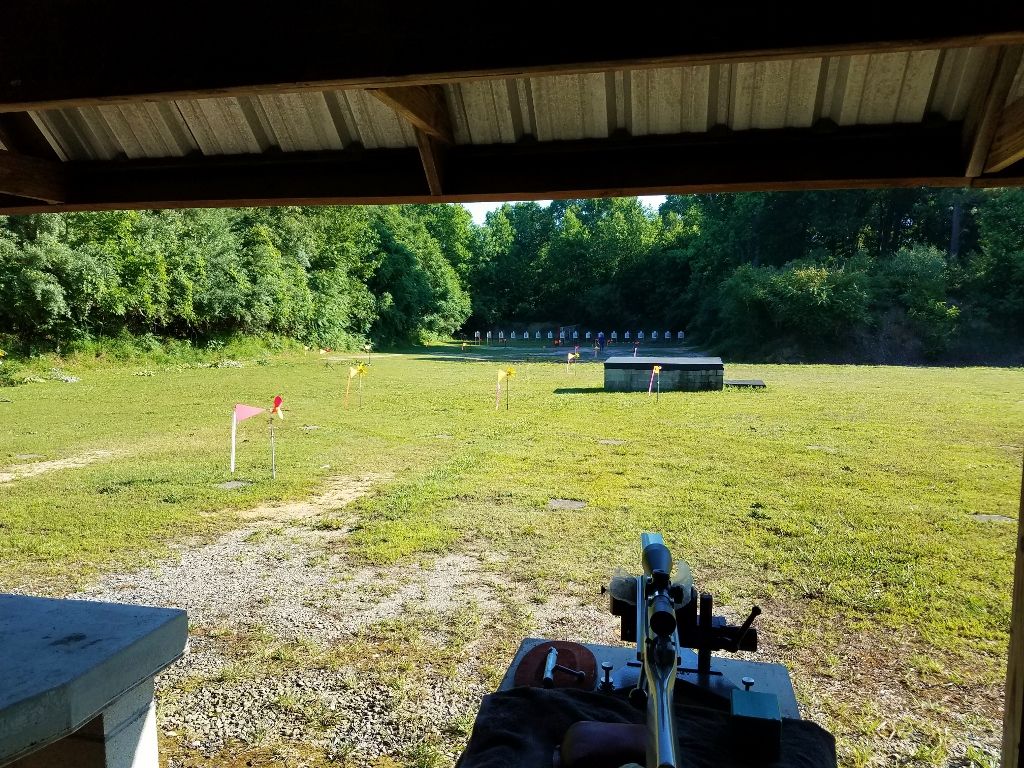 View from the bench. You’ll notice how obstructed my 60 and 85 yard flags are:  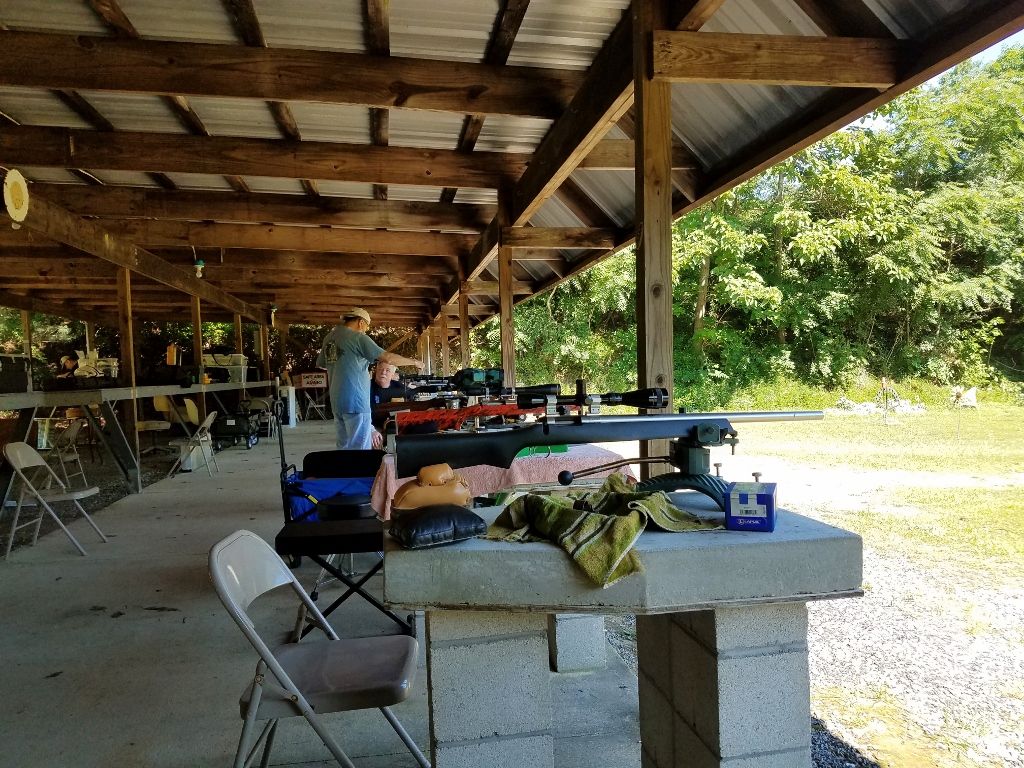 Scoring targets: 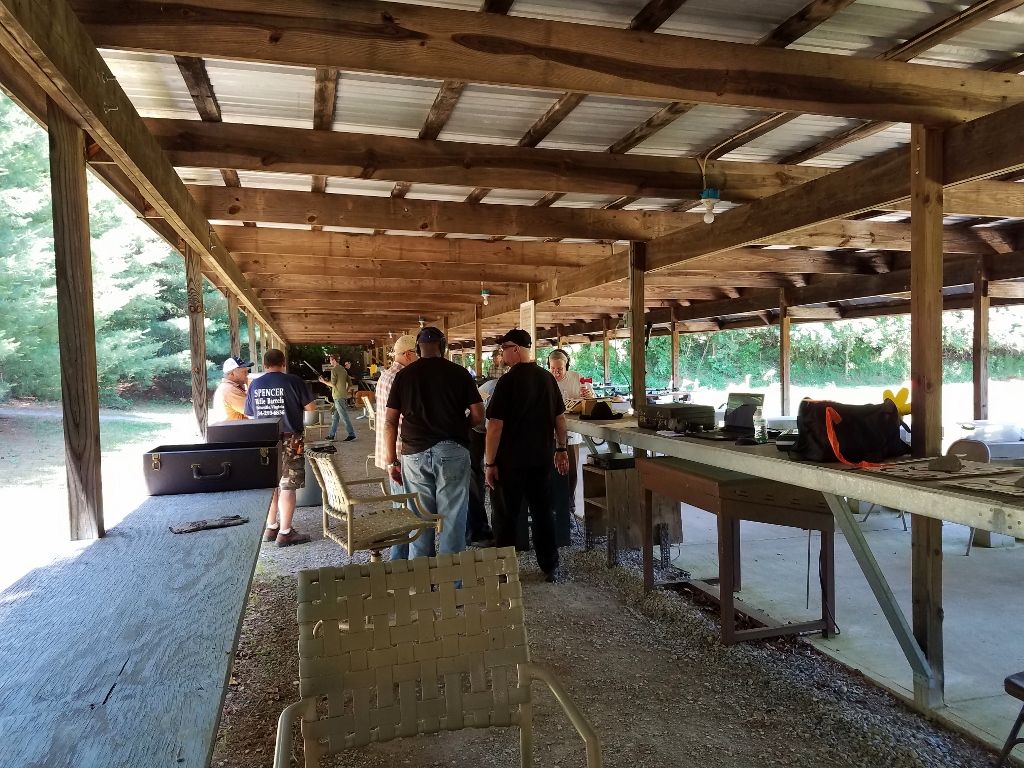 Flag retrieval, looking back towards the benches: 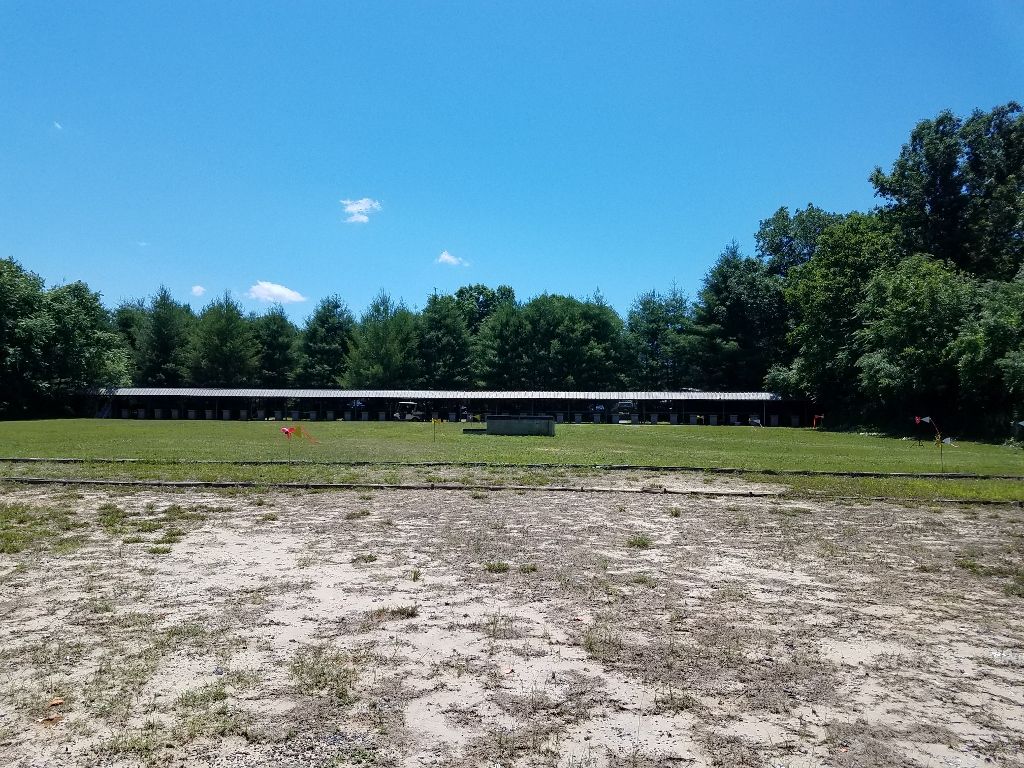 -Lee www.singleactions.com"Chasing perfection five shots at a time" |
|
ProGun
.30 Stingray

Posts: 246
|
Post by ProGun on Jun 6, 2017 19:21:39 GMT -5
How'd that new rest work out? Get you anything that you may not have gotten otherwise?
|
|
|
|
Post by cherokeetracker on Jun 7, 2017 17:14:15 GMT -5
Dang Lee, Now you sound like you are shooting in Texas.... Where the wind is erratic, and blows a lot of the time. I was hoping for closer to the top of the pack. Your still my horse even if you don't ever win. But You WILL.
Charles
|
|
|
|
Post by moosemeat on Jun 13, 2017 21:20:56 GMT -5
Lee please keep this going. I'm a F T/R shooter and am learning a lot from this. So much from your write up of the short range game. I just read all 40 pages of this post. Thank you for your time and energy invested.
|
|
|
|
Post by Lee Martin on Jun 29, 2017 18:54:37 GMT -5
Scope Checker _________________________ Here’s something I always wanted to mill out of aluminum but never took the time to do. What you see below is a scope checker, patterned after Charlie Hood’s design. Recently, Mike Ezell (www.ezellcustomrifles.com) began producing these with Charlie’s permission. For what he charges, it doesn’t pay to flip the switch on our Bridgeport. The quality is first-rate. Top-side: 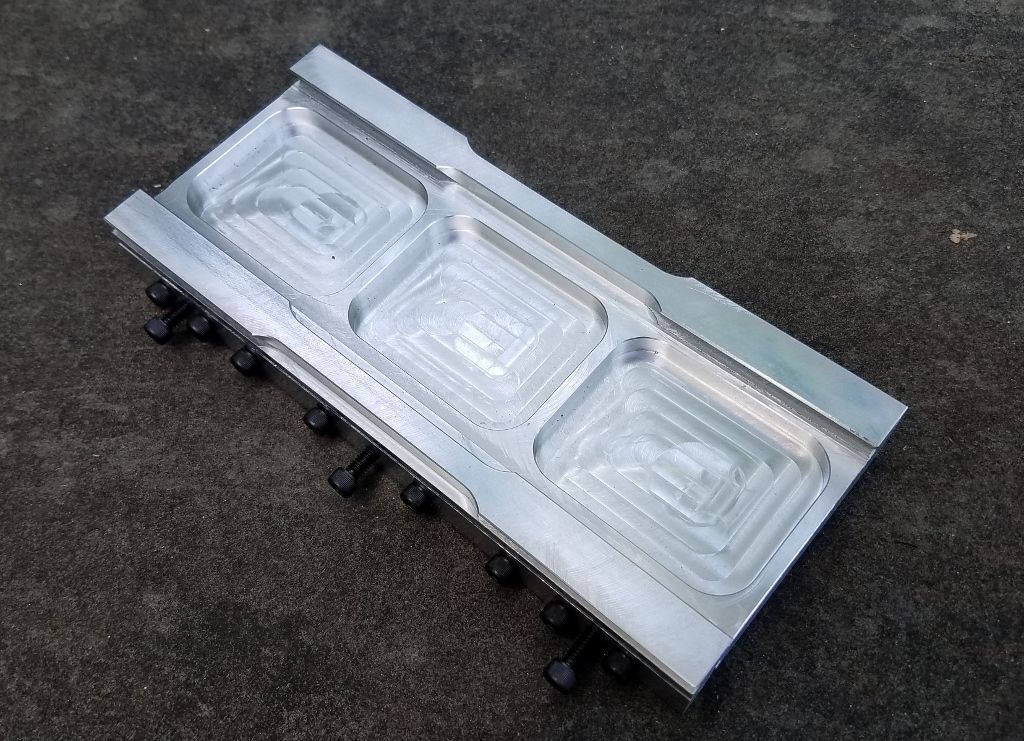 Side shot: 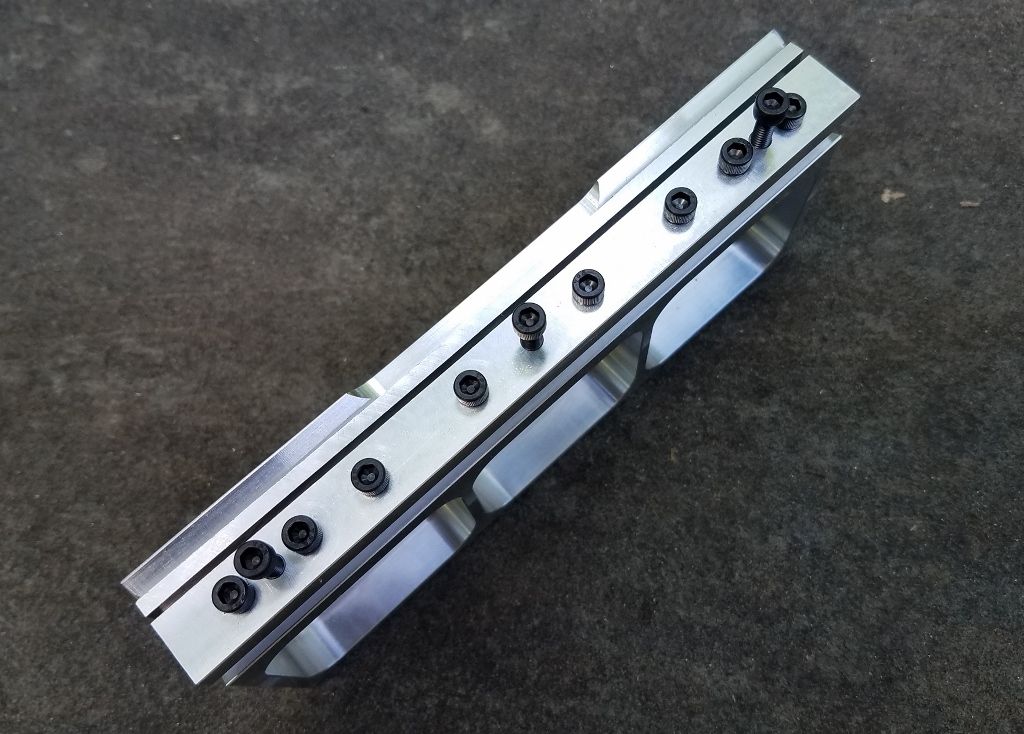 Underneath: 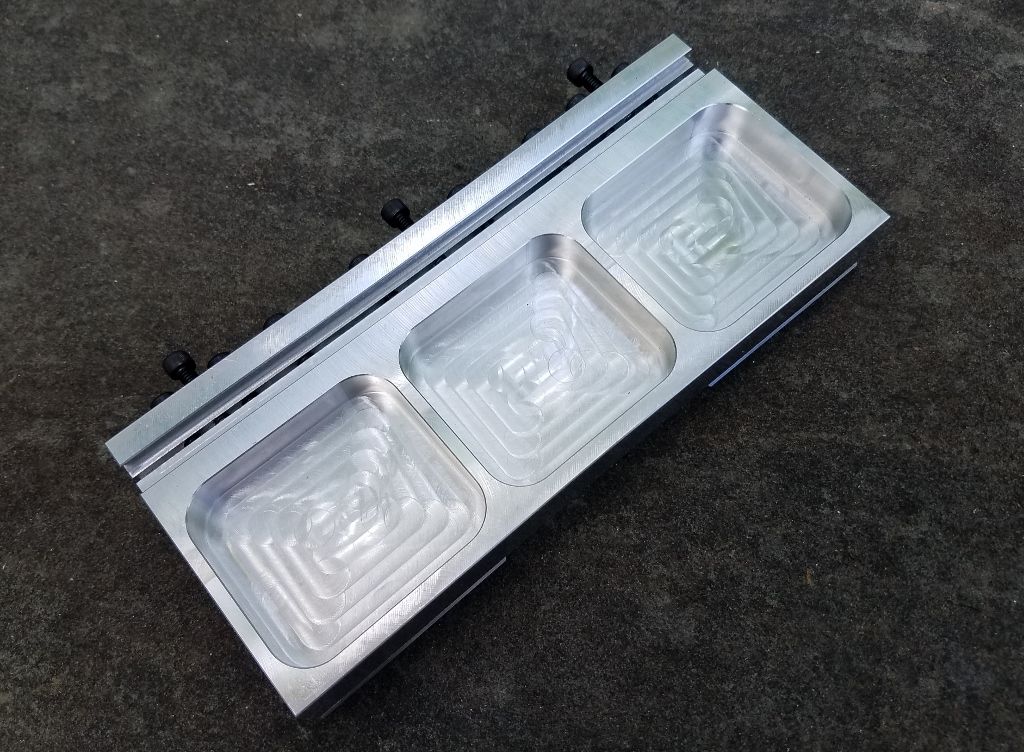 End-view: 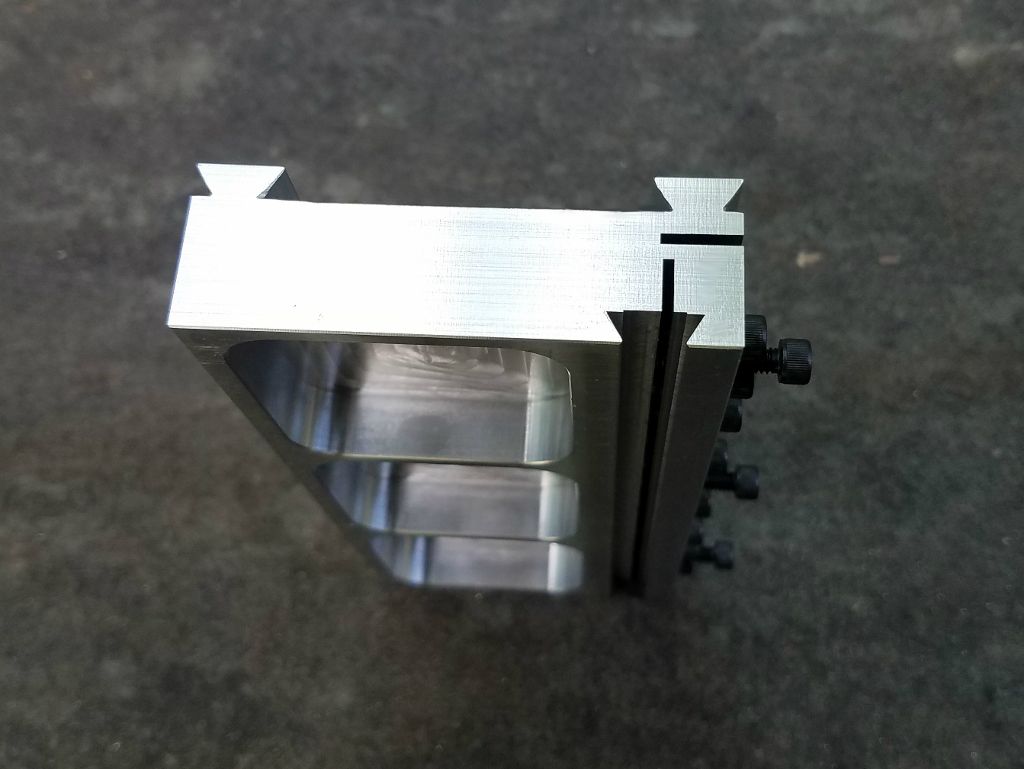 What does it do? In benchrest, or any precision rifle discipline, the scope has to hold POA. If it wanders, you’re done. Erector tube shifts, even a thousandth or less, kills performance. You’ll remember a few months ago I suspected my March may be moving. I compared it to a known scope and eventually pinned the problem on the rest. But how I validated the March wasn’t ideal. I’d shoot the Leupold, swap out for the March, shoot another group, and attempt to diagnose differences. This scope checker solves all that. How does it work? You’ll notice the underside has a rail slot, while the top surface contains parallel dovetails. Two scopes are simultaneously mounted and the checker is attached to your gun’s scope base. The first scope must be a known entity. Meaning, it has been validated as absolute solid on holding POA. A lot of guys prefer frozen scopes for this control. You then mount the questionable glass on the second rail. Both reticles are adjusted to the exact same POA. Fine grid paper is highly recommended for the target. POI isn’t important, except you’ll want the bullet to print away from the aiming point. Next, fire a shot and view both reticles. If they’re still in agreement on POA, the questionable scope likely isn’t moving. If their POAs diverge, the internals shifted. Below is an illustration of this. Notice how the second scope no longer agrees with the first? The POA is higher to the left than the confirmed optic: 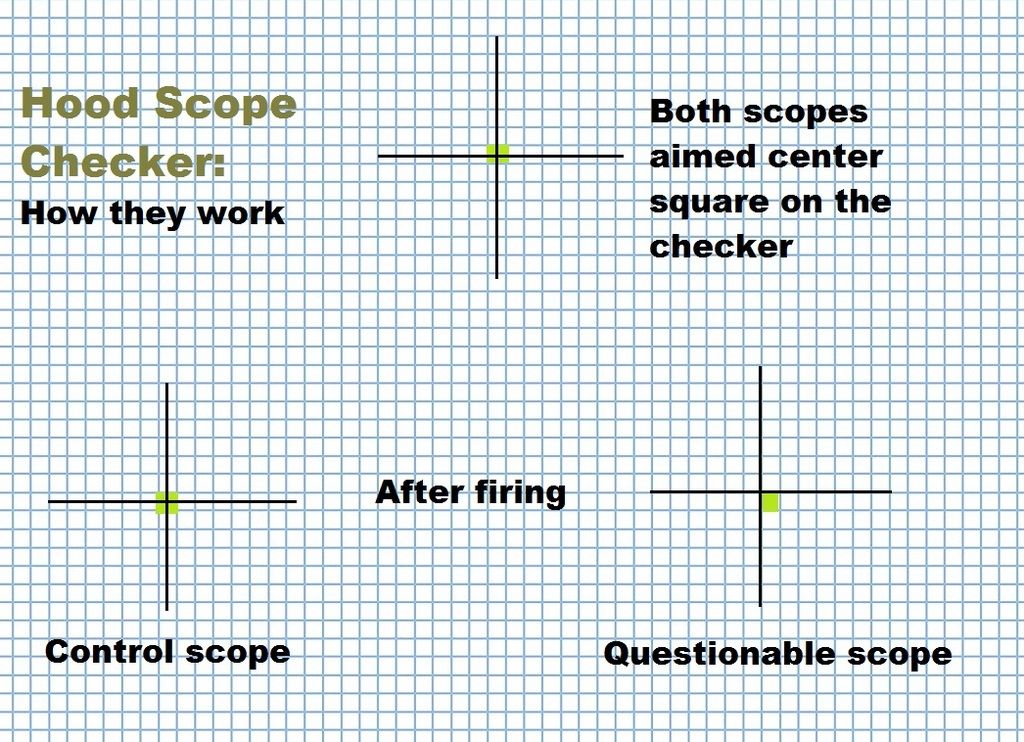 I hope this doesn’t see much use. -Lee www.singleactions.com"Chasing perfection five shots at a time" |
|
|
|
Post by Lee Martin on Jul 5, 2017 19:21:13 GMT -5
Match #12 – VFS, Mechanicsville, VA ___________________________________________ Saturday marked my 1-year anniversary of benchrest competition (12-months and 12-matches went quick). Winds were mild but the temperature hit 94 degrees down around Richmond. Surprisingly, mirage wasn’t that bad. I finished middle of the pack again and the gun performed well.  Looking at the 2nd half of the year, I hope to attend 10 more events. -Lee www.singleactions.com"Chasing perfection five shots at a time" |
|
|
|
Post by cherokeetracker on Jul 5, 2017 21:20:41 GMT -5
The scope checker is wild as can be. It sure doesn't seem to be a year of you shooting this discipline. I do not know who has learned the most here. But I know that I have learned a lot. Remember how I, thought it was all going to end, when you had finished the rifle? Wow what a journey.
Charles
|
|
|
|
Post by Lee Martin on Jul 20, 2017 20:00:57 GMT -5
.30 Stingray Update ___________________________________ It has been 8 months since I ordered a Lederer .30-caliber barrel. James is producing very fine blanks and is in high demand. I have no hard feelings on the wait; I’m glad to see his business taking off. But all the same, I’m ready to try the .30 Stingray. Last Friday I chambered my Krieger 1:17” HV (4-groove, cut). In doing so, I switched to Deltronic pins for preliminary centering. These gauges are precision ground, hardened, and graduated in ten-thousandths. Conventional pin gauges increment in thousandths (0.0001” vs 0.001”). They aren’t cheap but make indicating much faster. I ordered a set for 6mm and another for .30. The 6 has a nominal pin of 0.2370” with twelve ten-thousandths up and down. So it spans 0.2358” – 0.2382”. The .30-cal uses a 0.3000” nominal, covering 0.2988” – 0.3012”.  The 0.3000” is placed in the breech and centered to a dial reading of 0.0000”. The same is done at the muzzle end after the barrel has been cut close to final length. My spider is adjusted to 0.0000” runout.    Now here’s the test of a good barrel. The Deltronic pin was centered off the lands. I next went in with a probe and checked all four grooves. Every one zeroed exactly to the other three. That tells me two things. First, Krieger cuts dead-on rifling. Second, the Deltronic pins are a wonderful way to center up.  Saturday I’ll fire-form the first lot of .30 Stingray. I loaded Sierra 125 grain Pro-Hunters because they’re inexpensive and I had some on hand. They’re seated long and jammed into the rifling for positive headspace. Fire-forming sharpens the shoulder to 40 degrees, moves the datum ahead 0.030”, and straightens the sidewalls a hair.  And want to know the irony of all this? I went out Friday night and found a package on my doorstep. It contained the two Lederer barrels I ordered last fall. One in 6mm, the other a 1:18 thirty. -Lee www.singleactions.com"Chasing perfection five shots at a time" |
|
|
|
Post by Markbo on Jul 20, 2017 21:57:19 GMT -5
Thats so cute!
|
|
|
|
Post by cherokeetracker on Jul 30, 2017 8:04:21 GMT -5
New Packages of parts can be like a shot of adrenaline for me sometimes. It gives me that new energy to get back on a project that begs for completion. I have too many going on right now. With the 30 caliber barrel going and ammo ready to fireform, the door to a new chapter, sounds ready to breach. Christmas in July!!! I am excited about the Stingray... I do believe that it is going to be a game changer.
Charles
|
|
|
|
Post by Lee Martin on Aug 1, 2017 20:05:24 GMT -5
.30 Stingray Fire-Forming ______________________________________ I recently fire-formed fifty .30 Stingrays. They turned out well, both on dimensions and head-spacing.  The load was 28.5 of LT-30, which is a fast version of LT-32. Its burn rate is quite close to H4198, the dominant 30 BR powder. They went 2,800, so I think the magical 3,000 fps node is possible with 115 grain bullets. Three shells were reloaded two more times, for a total of three firings. These were sent to Whidden Gunworks, where they’ll be used to make a FL sizing die. That die will match the fired brass, size a minimal amount at the shoulder junction and 200 mark, and accept Redding or Wilson neck bushings. A quick word about barrel break-in, since the forming was done on a new Krieger. Ask five gunsmiths about breaking in a barrel and you’ll likely get five different answers. I’d venture to say none of them are wrong. Here’s what I think though. The notion that the lands and grooves need broken-in is misguided; at least with the premium blanks used throughout precision shooting. Both cut and button rifled barrels are lapped for finish and/or dimension (finish on cut, finish and dimension on button). Therefore the bores come already polished. What we’re really attempting to break-in is the chamber lead and throat. When you ream a barrel, the cut marks are perpendicular to the bore’s axis. It doesn’t matter what cutting oil you use, they’ll be there. Incidentally, I just tried Viper Venom cutting oil on this Krieger. It worked fine, but no better than my dad’s affinity for used motor oil. “Used” being the key word. You want old, dark motor oil. Not fresh and new from the jar. I bore-scope all our chambers and couldn’t see any difference with the Viper Venom. Smells better than burnt Valvoline though. Back to the chamber. Basically, the machine marks in the lead grab more copper than usual early on. That’s because those ridges haven’t been worn down yet. This creates excessive jacket stripping and heavier copper build in your new bore. To stay ahead of this, I fired one shot and cleaned the barrel. This was repeated for five rounds and the patches returned vibrant blue. After one-shot, one-clean for five, I switched to five shots before cleaning. This was done across three cycles. So for the first 20 rounds, the gun was cleaned eight times. Then I went to 10 shot intervals before cleaning. Once I got to 20, the blue patches changed to dark black fouling. The barrel had settled in. Bore-scoping proved the lead was polished. Less copper on the patches was further evidence of a successful break-in. -Lee www.singleactions.com"Chasing perfection five shots at a time" |
|
|
|
Post by moosemeat on Aug 10, 2017 0:04:12 GMT -5
Well you did it... You motivated me to drag my F T/R rifle to a local bench rest match, mostly cause my long range match got moved. It was NOT a registered match but a 25 round club match with a ground hog match after. I got 1st in tge BR match and 3rd in the ground hog match. My best group was a .196. I thank you.
|
|
|
|
Post by Lee Martin on Aug 22, 2017 19:18:13 GMT -5
The Economics of Bullet Making __________________________________________ Bullet making got cheaper. For the first 10,000 6mm’s I formed, Hines jackets were $105/1000. They just dropped that to $80/1000 (probably to compete with J4’s lower pricing). I also decided to switch to higher antimony lead wire. No real reason for doing so, except the premiere core maker in BR uses Crown Metal’s “bullet wire”. It contains 99.25% lead and 0.75% antimony. To date I’ve swaged on 0.10% antimony wire from Rotometals. They got $89.00 for a 25 lb spool, or $115 with shipping. I called Crown Metals out of Milwaukee and was quoted $97 per 50 lb spool. I ordered a 0.187” roll for 6mm and a 0.250” for .30-cal. The total for 100 pounds came to $228, shipped. Left – 0.187” wire for 6mm, Right – 0.250” wire for .30  Savings – I used to pay $146 in materials to swage a thousand 67 gr 6mm’s. With Hines cutting their price and moving to Crown Metals, I’m now paying $96. Commercial benchrest bullet swagers get around $270/1000 for light weight 6mm. So I save $174, or 65%. It takes 12 hours to run 1,000, putting my labor at $14.50/hour. In essence, I got a $4.20/hour raise. I’ve cut and squirted 2,000 6mm cores from the Crown wire. It shears cleaner than pure lead and swages equally well. The extra antimony also makes it less prone to dings dropping from the cutter and in tumbling. I expect core seating and point-up to be smooth too. -Lee www.singleactions.com"Chasing perfection five shots at a time" |
|
|
|
Post by moosemeat on Aug 24, 2017 21:28:44 GMT -5
How long will it take you to recoup the money invested in the bullet making operation with you making your own?
|
|